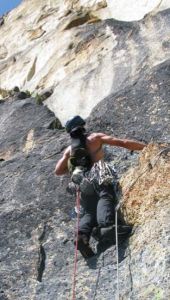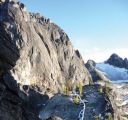The Southern Man, South Early Winters Spire IV 5.12a or 5.10a C1 |
||
Washington Pass, Washington, USA | ||
| ||
|
Avg time to climb route: 5-9 hours
Approach time: 1.5-2.5 hours Descent time: 1.5-2.5 hours Number of pitches: 9 Height of route: 1,000' Overview
This is one of the best 5.12s at Washington Pass. Steep, straightforward climbing, clean fall potential, and ample protection make this a great option for those looking to break into the 5.12 grade. It is also a good option for 5.10 climbers looking to gain some aid climbing and big wall experience. The Southern Man is consistently steep and gets steeper on the second half, giving it an ominous big wall feel. Photos
- View all 1 photos of The Southern Man as: Thumbnails | Slideshow
Climber Beta on The Southern Man
Find other routes like
The Southern Man
Route History
The Southern Man was first climbed in August of 2008 by Mark Allen, Leighan Falley, and Joel Kauffman. The route had long intrigued Allen, particularly the continuous dihedral running nearly to the top of the wall. The lower section of this dihedral was part of the obscure 1965 Anderson-Myher-Richardson-Young route, which climbs to the left of the lower East Buttress and traverses much of the south face toward the southeast face of the spire. This 1965 route intersects the 1968 Beckey-Leen Direct East Buttress route on South Early Winters Spire atop Pitch 4 on the large ledge. The 1965 party bivied on this ledge, climbed up a pitch on what is now Southern Man and retreated from this steep system via a two-pitch pendulum, then finished on easier ground to the left.On August 24th Allen, Falley, and Kauffman climbed the Direct East Buttress until the large ledge below the first bolt ladder a 500-foot dihedral to the right of the 1968 Beckey-Leen Direct East Buttress route on South Early Winters Spire. Kauffman led Pitch 5 and began finding old iron near an alcove. The group hypothesized that these must have been left by the 1965 party before they pendulumed to the left. The climbing was stellar and the three climbers hung like bats in a crack belay under the alcove roof. Kauffman continued his block head-on with steep aid climbing up a dirty crack. After 100 feet, Kauffman set a belay and Allen took over. He stretched the rope out a full 60m where now most climbers break it up into two pitches. Allen’s lead was even dirtier than the last, but the steep dihedral yielded straightforward and solid aiding. Allen fixed the line and watched the day’s light fade to gray as the others jugged. After 50 feet of climbing to the crest, they topped out in the dark. Allen reported that the southeast face felt like a mini big wall: steep, exposed, and requiring tricks. They named their route the Southern Man because of the aspect of the route and after the Neil Young song, Southern Man, from his album, After the Gold Rush. Other History First free climbed in September 2009 by Bryan Burdo and Bobby Mathews. Burdo had looked at the line while cleaning and bolting The Hitchhiker in 2006 and 2007 but thought it looked like extremely dirty 5.12 climbing with lots of loose looking blocks. After Allen, Kauffman, and Falley had climbed the route, Burdo began to wonder more about it. Allen sent Burdo pictures and a topo and gave him a bunch of beta. Burdo teamed up with Bobby Mathews and together they battled through the dirt to make the first free ascent. Bobby Mathews even onsited the route. They decided to break up the second headwall pitch, which is how most parties typically do. “Most people just don’t bring enough gear to adequately protect the 200 feet pitch.” They both thought that the rock and the quality of climbing was superb but the route was super dirty. Burdo went back on his own two weeks later to put a bolt on The Passenger and rapped into The Southern Man. He put an enormous amount of effort into the crux pitches and scrubbed and gardened the 300 feet headwall until it was pretty darn clean. Burdo says, “Now one of the cleaner harder routes at the pass, 300 feet of sustained slightly overhanging 5.12.” Strategy
You might run into parties on the lower half of the route, which is shared with the super popular Direct East Buttress. Once on the second half, sharing the route with other parties is extremely rare. The start of Pitch 5 where Southern Man leaves the DEB there is a little devious route finding and the rock a little loose and dirty, but the rock quality soon becomes excellent and the route finding more straightforward. In fact, for the three headwall pitches after Pitch 5, the route finding couldn’t be more obvious as you follow a steep soaring splitter crack up the horizon. All the crux headwall pitches have extremely straightforward climbing and solid protection. The crux Pitch 6 is mostly sustained mid-5.11 climbing with a body length of 5.12a finger locks, poor feet with only one good rest on the whole pitch. There is typically a fixed nut at the crux; you’ll appreciate it being there and you should leave it for other climbers after you. The first free ascent team fixed it there on purpose.Place gear around your waist or risk taking all the best finger locks for your hands. A 4” piece isn’t necessary but you can use it lower down on the route during the wider sections of the DEB, which saves you valuable finger-sized pieces at the belays at the top of the 6th and 7th pitches. Pitch 7 is mostly sustained 5.10+ and lower 5.11 climbing on similarly steep finger cracks with poor feet and a handful of rest thrown in. Pitch 8 looks like it should be easier than it is and is more sustained, mostly finger-sized climbing, but once over the bulge, the climbing eases. You can pull through all the cruxes on gear and this is a great place for 5.11a/b climbers to push themselves with abundant protection and a clean fall. A few parties climb this route and short fix and aid climb these three pitches to work on their big wall skills. If you are only a mid-5.10 climber, you should bring aiders and plan on aiding nearly all of the headwall cracks. It is not practical to return to the base of the route, which means going lighter so you can carry all your gear up and over the route. Retreat Storm
There are no fixed anchors on the route. There are some trees on the lower part of the route but you need 60m ropes to go from tree to tree. Up higher, retreat means leaving gear, two ropes means leaving less gear. The route dries out fairly quickly after a storm, but if you are hoping to onsite or red point this route, give the wall a couple days to dry, as the crux section can seep a little the day after a storm.
Everything You Need to Know About
Washington Pass
Search the internet for beta on
The Southern Man
|
Other Routes on South Early Winters Spire
|





